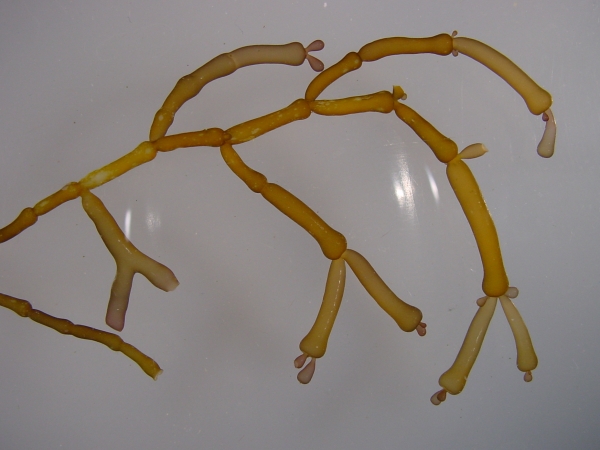
Main Page | References
Gracilaria salicornia (C.Agardh)

Gracilaria salicornia (C.Agardh)
Description: Plants frequently decumbent and imbricate, spreading in clumps to 30 cm or broader, often acumulating rocks and pebbles between branches; or erect from inconspicuous disklike holdfast, with secondary attachments here and there; axes 3-18 cm long and 1.5-4 mm broad, cylindrical to compressed, brittle; branches usually irregularly arranged, occasionally dichotomous distally; axes and branches regularly to irregularly constricted or uninterrupted, or both conditions occuring on same plant or adjoining plants. Cortex 1-2 layers, cells 4-6 by 10-12um, basal hair cells common; medullary cells relatively small. Tetrasporangia scattered over surface. 16-20 by 40-45um Spermatangia in pits. Cystocarps globose, not beaked, constricted at base, 1.5-1.8 mm diam. with few to many tubular nutritive cells; pericarp cells in relatively straight anticlinal rows of oval to rounded cells.(Abbott, 1999: p.216)Introduction and Origin: 71-74 Kaneohe and Waikiki. Gracilaria salicornia was brought in from the Big island of Hawaii. The date G. salicornia originally arrived at the Big Island is unknown.
Hawaiian Distribution: Oahu and Hawaii Island. Gracilaria salicornia is found throughout all of Kaneohe Bay and Waikiki. In Hawaiian waters plants are usually sterile, but tetrasporangial and more rarely gametangial specimens have been collected. Populations are increasing in locations with relatively low wave action.
Habitat: Intertidal to subtidal, in tidepools and reef flats, to 4 m deep. Intertidal plants are smooth, without constrictions, while subtidal plants are often constricted.
Environmental Effects: G. salicornia alters reef and mud bottom by creating a single, monospecific mat.
World Distribution: Type locality: Manila, Philippines. Widely distributed in the Indian and warm Pacific oceans.
Commercial Interests: Gracilaria salicornia was brought in from Hilo Bay as a possible source for agar production for Oahu.
Rate of Spread / Method: The dispersal rate is mainly determined by vegetative reproduction because G. salicornia is rarely fertile. Currents can carry fragments for long distances (Rodgers, 1999). The doubling rate for G. salicornia takes around 15 days.
Factors likely to influence Spread and Distribution: Sediments are a source of nutrients for G. salicornia.Temperature, and other environmental conditions that may determine reproduction, as well as competition for substrate with other algal species, might inhibit G. salicornia's growth. The thallus is easily fragmented, fragments acting as propagules for clonal reproduction. Large clumps, about 20 cm high, frequently forming round, compact cushions that resemble tumbleweeds, can be seen rolling along the reef, no longer attached to the substrate.
Reasons for Success: The thallus is easily fragmented, fragments acting as propagules for clonal reproduction. The main reason for the successful settlement of G. salicornia is its phenotypic plasticity, both morphological and physiological. It may grow into short stubs less than 1 cm off the substrate, or into large clumps almost 20 cm high, frequently forming round, compact cushions that resemble tumbleweeds, which can be seen rolling along the reef, no longer attached to the substrate. G. salicornia produces pigments in different concentrations along different portions of its thallus, responding to differences in the intensity and quality of light reaching each portion. The tips of the thallus are a bright orange-yellow, rich in carotenoids, while the base is dark purple, rich in phycobilins. The middle section of the thallus is green, richer in chlorophyll than the other two portions. This light-induced shifting of pigments reduces photoinhibition, enabling G. salicornia to withstand higher levels of irradiance (Smith, 2000).
Control Methods: None used. Harvesting for food by community would likely decrease its abundance.
References: Rodgers, S. E, Cox. 1999. Rate of spread of introduced Rhodophytes. Pacific science 53:232-241. Dr. Celia Smith. Lecture BOT 351 Tropical Ecosystems.University of Hawai`I at Manoa. Fall of 2000.